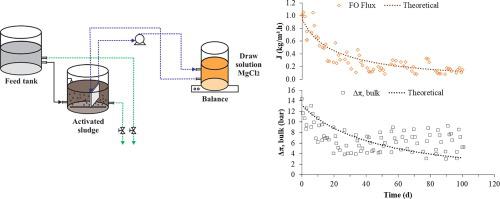Chemical Engineering Journal ( IF 13.3 ) Pub Date : 2020-09-22 , DOI: 10.1016/j.cej.2020.127074 Yuri Abner Rocha Lebron , Priscila Barbosa Moser , Victor Rezende Moreira , Gabriel Rodrigues dos Anjos Silva , Amanda Soalheiro , Bárbara Pimenta de Souza , Eduardo Coutinho de Paula , Miriam Cristina Santos Amaral

|
The present work considered an osmotic membrane bioreactor (OMBR) for the treatment of a complex and recalcitrant refinery wastewater. Magnesium chloride (MgCl2) was employed as draw solution (DS) to minimize the effects of salinity build up within the mixed liquor (ML). The flux decrease was mainly attributed to the salinity build up. Due to the higher contaminant retention time compared to conventional membrane bioreactor or hybrids UF-OMBRs, the recalcitrant compounds started to be degraded. Moreover, the reverse flux of magnesium favored a higher granulation of the sludge, which in turn enhanced nitrification and denitrification processes. The increase in fouling resistance was attributed to deposits formation, as showed in SEM micrographs and EDX spectra, and the pore blockage by low molecular weight compounds originated by the biological degradation. The increase in salinity (maximum ~10 g/L) lead to a higher production of SMP and EPS protein-like substances, which have lower effect in fouling propensity. Furthermore, even though the ML volatile suspended solids (MLVSS) and ML suspended solids (MLSS) decreased, the mean MLVSS/MLSS ratio was 0.75 ± 0.15, which shows that the salinity build up did not degrade the biological activity. In this sense, when the OMBR is operated with MgCl2 as DS, the permeate shows good physical–chemical quality due to increased contaminants retention time, demonstrating that the system can be used even for applications that demands elevated physical–chemical quality.
中文翻译:

渗透膜生物反应器(OMBR)在炼油厂废水处理中:较低扩散系数的牵引溶质对工艺性能的影响
目前的工作考虑了一种渗透膜生物反应器(OMBR),用于处理复杂难处理的炼油厂废水。氯化镁(MgCl 2)用作汲取溶液(DS),以最大程度降低混合液(ML)中盐分累积的影响。通量减少主要归因于盐分的积累。由于与常规膜生物反应器或杂化UF-OMBR相比,污染物保留时间更长,因此难降解化合物开始降解。此外,镁的反向通量有利于污泥的更高颗粒化,进而增强了硝化和反硝化过程。耐污垢性的提高归因于沉积物的形成(如SEM显微照片和EDX光谱所示),以及由于低分子量化合物的孔堵塞是由生物降解引起的。盐度的增加(最大〜10 g / L)导致更高的SMP和EPS蛋白样物质的产生,在结垢倾向方面影响较小。此外,即使ML挥发性悬浮物(MLVSS)和ML悬浮物(MLSS)减少,平均MLVSS / MLSS比仍为0.75±0.15,这表明盐分的积累不会降低生物活性。从这个意义上讲,当OMBR与MgCl一起运行时2作为DS,渗透物由于增加了污染物保留时间而显示出良好的物理化学质量,这表明该系统甚至可以用于要求提高物理化学质量的应用中。











































 京公网安备 11010802027423号
京公网安备 11010802027423号